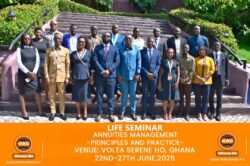… becomes a feature of western leaders’ visits to West Africa
Cape coast Castle has, since becoming a tourist site, attracted many tourists to Ghana and continues to be a feature of western leaders who visit Africa, especially the western part. A visit to the Cape Coast Castle or the Elmina Castle will always be an emotional one. I watched a movie on the slave trade recently, where Will Smith featured in, and the story line was one depicting terror and pain and suffering. This followed events the slaves were subjected to upon arrival in the Americas. They followed a long journey on foot from the northern part of Ghana to the south, where the castles where found. They again had to embark on another long journey in the most unbearable conditions across the Atlantic Ocean. The journey, from beginning to end, is all about suffering.
The latest leader to add her voice to this sorrowful experience is United States Vice President Harris, who toured the Cape Coast Castle on Wednesday. As reported by CNN, Vice President Kamala Harris emerged from the female slave dungeon at Cape Coast Castle visibly shaken. Inside the famous slave trading outpost’s dungeon, Harris set a bouquet of flowers down and placed her hand on the centuries-old wall, connecting herself physically to the sorrow of the Africans it once imprisoned. After the tour, she said: “Being here was immensely powerful. The crimes that were done here, the blood that was shed here, the horror of what happened here must always be remembered. It cannot be denied. It must be taught; history must be learned”.
The castle attracted President Obama in 2009 and after the visit, this is what he had to say: “Michelle, the children, as well as other members of my family, just got an extraordinary tour of this castle. It is reminiscent of the trip I took to Buchenwald because it reminds us of the capacity of human beings to commit great evil. One of the most striking things that I heard was that right above the dungeons in which male captives were kept was a church, and that reminds us that sometimes, we can tolerate and stand by great evil even as we think that we’re doing good.
“You know, I think it was particularly important for Malia and Sasha, who are growing up in such a blessed way, to be reminded that history can take very cruel turns; and hopefully, one of the things that was imparted to them during this trip is their sense of obligation to fight oppression and cruelty wherever it appears, and that any group of people who are degrading another group of people have to be fought against with whatever tools we have available to us.
So obviously, it’s a moving experience, a moving moment. We want to thank those who arranged for the tour and the people of Ghana for preserving this history. As painful as it is, I think that it helps to teach all of us that we have to do what we can to fight against the kinds of evils that sadly still exist in our world, not just on this continent, but in every corner of the globe. And I think as Americans and as African Americans, obviously, there’s a special sense that on the one hand this place was a place of profound sadness; on the other hand, it is here where the journey of much of the African-American experience began. And symbolically, to be able to come back with my family, with Michelle and our children, and see the portal through which the diaspora began, but also to be able to come back here in celebration with the people of Ghana of the extraordinary progress that we’ve made because of the courage of so many, black and white, to abolish slavery and ultimately win civil rights for all people, I think is a source of hope. It reminds us that as bad as history can be, it’s also possible to overcome.”
There are many international celebrities who have also visited the Cape Coast Castle and have provided very good reviews. The videos tourists share with their friends and family have all contributed to marketing the castle. According to researchers, out of the 66 forts and castles built along the coast of Africa, 43 were found in Ghana because of the rocky beaches. This explains the connection the country continues to enjoy with the diaspora. The future is Africa, and we need to take advantage and position our tourism for the future. Many of these visits must be encouraged.
For those who have not yet visited Cape Coast Castle, it’s important to visit and learn about it. Cape Coast Castle (Swedish: Carolusborg) is one of about forty ‘slave castles’ or large commercial forts built on the Gold Coast of West Africa (now Ghana) by European traders. It was originally a Portuguese ‘feitoria’ or trading post established in 1555, which they named Cabo Corso.
In 1653, the Swedish Africa Company constructed a timber fort there. It originally was a centre for the trade in timber and gold. It was later used in the Atlantic Slave Trade. Other Ghanaian slave castles include Elmina Castle and Fort Christiansborg. They were used to hold enslaved Africans before they were loaded onto ships and sold in the Americas, especially the Caribbean. This ‘Gate of no Return’ was the last stop before crossing the Atlantic Ocean. Cape Coast Castle, along with other forts and castles in Ghana, is included on the UNESCO World Heritage List because of its testimony to the Atlantic Gold and Slave Trades.
The first fort established on the present site of Cape Coast Castle was built by Hendrik Caerloff for the Swedish Africa Company. Caerloff was a former employee of the Dutch West India Company who had risen to the rank of fiscal before employing himself with the latter company established by Louis de Geer. As a former high-ranking officer of the Dutch, Caerloff had the friendly relations with the local chiefs necessary to establish a trading post. In 1650, Caerloff succeeded in getting the permission of the king of Fetu to establish a fort at Cabo Corso – meaning ‘short cape’ in Portuguese, later corrupted to English Cape Coast. The first timber lodge was erected at the site in 1653 and named Carolusborg after King Charles X of Sweden.
Karloff returned to Europe in 1655, leaving Johann Philipp von Krusenstjerna in charge of Carolusborg. Louis de Geer had, however, died in the meantime; and Caerloff got himself involved in a serious dispute with his heirs. In Amsterdam, he convinced merchants to give a financial injection to the Danish West India Company, for which he set sail to the Gold Coast in 1657, with the goal in mind to capture for Denmark the Swedish lodges and forts he had established himself. With the help of the Dutch, Caerloff succeeded in driving the Swedes out, leaving the Gold Coast on the captured ship Stockholms Slott, and with Von Krusenstjerna on board as a prisoner.
Karloff had left Samuel Smit, also a former employee of the Dutch West India Company, in charge of Carolusborg. The Dutch were able to convince Smit in 1659 of the rumour that Denmark had been conquered by Sweden, upon which Smit rejoined the Dutch West India Company, handing over all Danish possessions to the Dutch. The King of Fetu was displeased with this, however, and prevented the Dutch from taking possession of the fort. A year later, the king decided to sell it to the Swedes. After the king died in 1663, the Dutch were finally able to occupy the fort.
The Danes had, in the meantime, established another fort – Fort Frederiksborg (1661), just a few hundred metres east from Carolusborg. Although situated perfectly to launch an attack on Carolusborg, the English capture of Carolusborg (1664) during the prelude to the Second Anglo-Dutch War prevented the Danes from challenging them; the English had reinforced the fort, which they named Cape Coast Castle, to such an extent that even Dutch Admiral Michiel de Ruyter deemed it impossible to conquer. As the Dutch had captured the former English headquarters at Kormantin and had rebuilt it as Fort Amsterdam, Cape Coast became the new capital of the English possessions on the Gold Coast.
In 1689, the pirate Duncan Mackintosh was hanged at the castle with a few of his crew, though he would not be the last pirate hanged at the fort. In 1722, the fort was the site where 54 men of the crew of the pirate Bartholomew Roberts were condemned to death, of whom 52 were hanged and two reprieved.
In 1762, an extensive spur ending in a tower was built on the western side; and in 1773, a high building along the north curtain was erected, during which the last remnants of the 17th-century fort were demolished. Greenhill Point, a bastion to the east of the castle, was replaced by two new bastions, with a sea gate in the middle. To the south, two new bastions, named Grassle’s Bastions, replaced an old round tower as the main defensive work. The tower, which now had no military use, was extended in the 1790s with two storeys, now becoming the governors’ apartments. The space below Grassle’s Bastions was used as the new slave dungeons.
Source: Wikipedia.
Philip Gebu is a Tourism Lecturer. He is also the C.E.O of FoReal Destinations Ltd., a destinations management and marketing company based in Ghana and with partners in many other countries. Please contact Philip with your comments and suggestions. Write to [email protected] / [email protected] Visit our website at www.forealdestinations.com or call or WhatsApp +233(0)244295901.Visist our social media sites Facebook, Twitter and Instagram: FoReal Destinations.
Gillian White
The famous actress and wife of actor Jai White is another Hollywood celebrity who has shed tears at the Cape Coast Castle. The actress, together with his partner Jai White and children, visited Ghana in January 2019 to take part in the Year of Return programme. As expected, Gillian and her family travelled to Cape Coast in the Central Region of Ghana to visit the castle. Gillian couldn’t hold back her tears as she toured the castle that was used to keep slaves captive before being shipped to Europe.
Anthony Anderson
American sitcom king Anthony Anderson is all the time in his jovial mood and hardly would one see him with a grim face or even imagine it. But when the famous comedian visited the Cape Coast Castle upon his arrival in Ghana, he lost his usual jovial and happy looking appearance. For once, Anthony Anderson looked emotional, sad and in utter shock as he was told the harrowing experience his forefathers were subjected to by their European slave masters. While he did well to hold his tears back, one could easily see the lively actor and comedian was emotional.
Other popular actors, including Boris Kodjoe, Netherland international Memphis Dapay, and actor Jai White, have all visited the castle in recent years but barely managed to hold back their tears. One thing is for sure, you cannot visit Cape Coast Castle and not get emotional, especially for blacks living in other parts of the world other than Africa.










